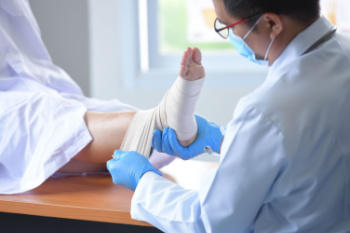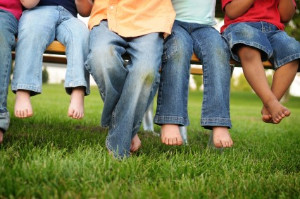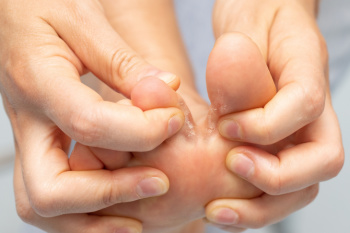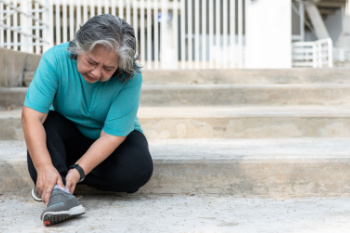
The ankle is a complex joint made up of bones, ligaments, tendons, and cartilage, all working together to support movement and stability. When an injury occurs, one or more of these structures may be affected. A sprain typically involves stretching or tearing of the ligaments that connect bone to bone, often on the outer side of the ankle. Strains affect muscles or tendons, while fractures involve a break in one of the bones, such as the tibia, fibula, or talus. Swelling, bruising, and pain usually follow, as blood vessels and tissues respond to the trauma. In some cases, cartilage may also be damaged, contributing to long-term discomfort or stiffness. Understanding which structures are involved is key to guiding proper treatment and healing. If you have persistent ankle pain or limited motion after an injury, it is suggested you see a podiatrist for a diagnosis and appropriate treatment.
Ankle pain can have many different causes and the pain may potentially be serious. If you have ankle pain, consult with Dr. John C. Lawlor from Florida. Our doctor will assess your condition and provide you with quality foot and ankle treatment.
Ankle pain is any condition that causes pain in the ankle. Due to the fact that the ankle consists of tendons, muscles, bones, and ligaments, ankle pain can come from a number of different conditions.
Causes
The most common causes of ankle pain include:
- Types of arthritis (rheumatoid, osteoarthritis, and gout)
- Ankle sprains
- Broken ankles
- Achilles tendinitis
- Achilles tendon rupture
- Stress fractures
- Tarsal tunnel syndrome
- Plantar fasciitis
Symptoms
Symptoms of ankle injury vary based upon the condition. Pain may include general pain and discomfort, swelling, aching, redness, bruising, burning or stabbing sensations, and/or loss of sensation.
Diagnosis
Due to the wide variety of potential causes of ankle pain, podiatrists will utilize a number of different methods to properly diagnose ankle pain. This can include asking for personal and family medical histories and of any recent injuries. Further diagnosis may include sensation tests, a physical examination, and potentially x-rays or other imaging tests.
Treatment
Just as the range of causes varies widely, so do treatments. Some more common treatments are rest, ice packs, keeping pressure off the foot, orthotics and braces, medication for inflammation and pain, and surgery.
If you have any questions, please feel free to contact one of our our offices located in Cape Coral and LaBelle, FL . We offer the newest diagnostic and treatment technologies for all your foot care needs.

Children and adolescents involved in sports are at risk for overuse foot injuries, which develop gradually from repetitive stress rather than from a single traumatic event. Common examples include Sever’s disease, a painful inflammation of the heel growth plate, and stress fractures that often affect the metatarsals. Tendonitis and plantar fasciitis can also occur in young athletes, especially those involved in high-impact activities like running, soccer, or basketball. These injuries may start as mild soreness but can worsen without rest or proper treatment. Growth plates in developing feet are more vulnerable to strain, making early recognition important. Wearing appropriate footwear, avoiding overtraining, and allowing time for recovery are key prevention strategies. Because lingering foot pain in children is not a normal part of growth, and untreated injuries can lead to long-term problems, it is suggested that you see a podiatrist for evaluation and guidance.
Ankle and foot injuries are common among athletes and in many sports. They can be caused by several problems and may be potentially serious. If you are feeling pain or think you were injured in a sporting event or when exercising, consult with Dr. John C. Lawlor from Florida. Our doctor will assess your condition and provide you with quality foot and ankle treatment.
Common Injuries
The most common injuries that occur in sporting activities include:
- Achilles Tendonitis
- Achilles Tendon Rupture
- Ankle Sprains
- Broken Foot
- Plantar Fasciitis
- Stress Fractures
- Turf Toe
Symptoms
Symptoms vary depending upon the injury and in some cases, there may be no symptoms at all. However, in most cases, some form of symptom is experienced. Pain, aching, burning, bruising, tenderness, tightness or stiffness, sensation loss, difficulty moving, and swelling are the most common symptoms.
Treatment
Just as symptoms vary depending upon the injury, so do treatment options. A common treatment method is known as the RICE method. This method involves rest, applying ice, compression and elevating the afflicted foot or ankle. If the injury appears to be more serious, surgery might be required, such as arthroscopic or reconstructive surgery. Lastly, rehabilitation or therapy might be needed to gain full functionality in the afflicted area. Any discomfort experienced by an athlete must be evaluated by a licensed, reputable medical professional.
If you have any questions, please feel free to contact one of our our offices located in Cape Coral and LaBelle, FL . We offer the newest diagnostic and treatment technologies for all your foot care needs.

Athlete’s foot is a common fungal infection that causes discomfort and irritation, typically between the toes. This condition is caused by fungi called dermatophytes, which thrive in warm, moist environments like sweaty shoes and socks. If you have athlete's foot, you may experience intense itching, redness, peeling, and in some cases, blisters or cracks. The feeling can be persistent and frustrating, making it difficult to wear shoes or walk comfortably. There are different types of athlete’s foot. Interdigital athlete's foot affects the space between the toes, while the moccasin type causes dry, scaly patches on the soles and sides of the feet. The infection can easily recur if not treated properly, as the fungi can survive on surfaces like towels, shoes, or floors. Poor hygiene and tight shoes can also contribute. If you are dealing with recurring athlete’s foot, it is suggested that you make an appointment with a podiatrist who can provide effective treatments, including prescribed antifungal medications.
Athlete’s Foot
Athlete’s foot is often an uncomfortable condition to experience. Thankfully, podiatrists specialize in treating athlete’s foot and offer the best treatment options. If you have any questions about athlete’s foot, consult with Dr. John C. Lawlor from Florida. Our doctor will assess your condition and provide you with quality treatment.
What Is Athlete’s Foot?
Tinea pedis, more commonly known as athlete’s foot, is a non-serious and common fungal infection of the foot. Athlete’s foot is contagious and can be contracted by touching someone who has it or infected surfaces. The most common places contaminated by it are public showers, locker rooms, and swimming pools. Once contracted, it grows on feet that are left inside moist, dark, and warm shoes and socks.
Prevention
The most effective ways to prevent athlete’s foot include:
- Thoroughly washing and drying feet
- Avoid going barefoot in locker rooms and public showers
- Using shower shoes in public showers
- Wearing socks that allow the feet to breathe
- Changing socks and shoes frequently if you sweat a lot
Symptoms
Athlete’s foot initially occurs as a rash between the toes. However, if left undiagnosed, it can spread to the sides and bottom of the feet, toenails, and if touched by hand, the hands themselves. Symptoms include:
- Redness
- Burning
- Itching
- Scaly and peeling skin
Diagnosis and Treatment
Diagnosis is quick and easy. Skin samples will be taken and either viewed under a microscope or sent to a lab for testing. Sometimes, a podiatrist can diagnose it based on simply looking at it. Once confirmed, treatment options include oral and topical antifungal medications.
If you have any questions, please feel free to contact one of our our offices located in Cape Coral and LaBelle, FL . We offer the newest diagnostic and treatment technologies for all your foot care needs.

People with diabetes are at a higher risk for ankle fractures due to weakened bones and reduced sensation in the feet and ankles. Neuropathy can make it difficult to feel injuries, which may lead to delayed diagnosis and treatment. Poor circulation and slower healing times also increase the risk of complications. Ankle fractures in diabetic patients can be more serious than in the general population. If not treated promptly, they can lead to infections, non-healing fractures, or even Charcot foot, a condition where the bones weaken and collapse. A podiatrist can provide a thorough evaluation and recommend the appropriate treatment, which may include immobilization, surgery, or custom orthotics. If you have diabetes and experience ankle pain, swelling, or difficulty walking, it is suggested you schedule an appointment with a podiatrist who can provide a thorough evaluation and recommend the appropriate treatment, which may include immobilization, surgery, or custom orthotics.
Diabetic foot care is important in preventing foot ailments such as ulcers. If you are suffering from diabetes or have any other concerns about your feet, contact Dr. John C. Lawlor from Florida. Our doctor can provide the care you need to keep you pain-free and on your feet.
Diabetic Foot Care
Diabetes affects millions of people every year. The condition can damage blood vessels in many parts of the body, especially the feet. Because of this, taking care of your feet is essential if you have diabetes, and having a podiatrist help monitor your foot health is highly recommended.
The Importance of Caring for Your Feet
- Routinely inspect your feet for bruises or sores.
- Wear socks that fit your feet comfortably.
- Wear comfortable shoes that provide adequate support.
Patients with diabetes should have their doctor monitor their blood levels, as blood sugar levels play such a huge role in diabetic care. Monitoring these levels on a regular basis is highly advised.
It is always best to inform your healthcare professional of any concerns you may have regarding your feet, especially for diabetic patients. Early treatment and routine foot examinations are keys to maintaining proper health, especially because severe complications can arise if proper treatment is not applied.
If you have any questions please feel free to contact one of our our offices located in Cape Coral and LaBelle, FL . We offer the newest diagnostic and treatment technologies for all your foot and ankle needs.








